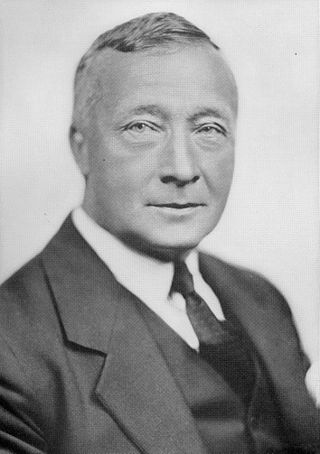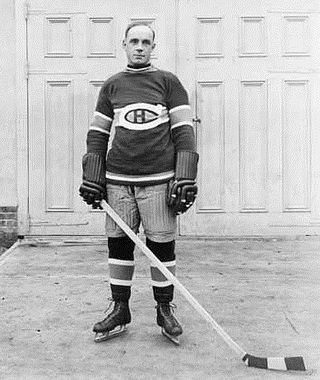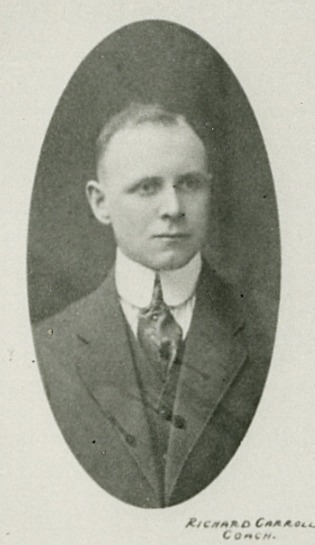
The St. Louis Eagles were a professional ice hockey team that played in the National Hockey League (NHL). Based in St. Louis, the Eagles played for only one year, the 1934–35 NHL season.

Frank Sellick Calder was a British-born Canadian ice hockey executive, journalist, and athlete.

Edward James Livingstone was a Canadian sports team owner and manager. He was the principal owner of the Toronto Shamrocks and the Toronto Blueshirts professional ice hockey clubs of the National Hockey Association (NHA), where his battles with his fellow owners led them to create the National Hockey League.

Wilfrid Arthur "Billy" Coutu, nicknamed "Wild Beaver", was a Canadian professional ice hockey defenceman who played ten seasons in the National Hockey League for the Montreal Canadiens, the Hamilton Tigers, and the Boston Bruins. Known for his fiery temper, Coutu was once given 42 penalty minutes in a 1923 playoff game against the Ottawa Senators, still a record to this day. He is the only player ever to have been banned from the NHL for life, as a result of his attack on a referee in 1927.

The Tulsa Oilers are a professional ice hockey team based in Tulsa, Oklahoma, and play in the ECHL. The Oilers played their home games at the Tulsa Convention Center until 2008 when they moved into the new BOK Center. For many years, the Tulsa Oilers name was shared with Tulsa's former minor-league baseball team that pre-dated the Tulsa Drillers. To reduce confusion in local news reporting, the hockey team was often called the "Ice Oilers".
The Pacific Coast Hockey League was an ice hockey minor league with teams in the western United States and western Canada that existed in three incarnations: from 1928 to 1931, from 1936 to 1941, and from 1944 to 1952.

William Osser Xavier Cook was a Canadian professional ice hockey right winger who played for the Saskatoon Crescents of the Western Canada Hockey League (WCHL) and the New York Rangers of the National Hockey League (NHL). A prolific scorer, Cook led the WCHL in goals twice and the NHL three times. He was named an all-star seven times between the two leagues. Known as "The Original Ranger", Cook was the first captain of the New York Rangers, scored the first goal in franchise history and led the team to two Stanley Cup championships.

Carl Potter Voss was an American ice hockey forward in the National Hockey League. He played for several teams between 1926 and 1938. He would later become a referee, and was inducted into the Hockey Hall of Fame in 1974 as a builder.

Leighton Alfred Emms was a Canadian ice hockey player, coach, team owner, and general manager, during nearly 60 years in hockey. Emms played 17 seasons of professional hockey as a left winger and a defenceman, including 10 seasons and 320 games in the National Hockey League. After playing, Emms had a 33-year presence in the Ontario Hockey Association, as the owner of the Barrie Flyers, Niagara Falls Flyers, and St. Catharines Black Hawks between 1945 and 1978. Teams that Emms coached or owned appeared in eight Memorial Cup tournaments, winning four Memorial Cups. He was nicknamed "Happy Emms" due to the sour look on his face, which was later shortened to "Hap Emms".
Clifford Joseph "Fido" Purpur was an American ice hockey player who played five seasons in the National Hockey League for the St. Louis Eagles, Chicago Black Hawks, and Detroit Red Wings between 1934 and 1945. He also played several years of minor hockey, primarily with the St. Louis Flyers of the American Hockey Association. After retiring he became a coach, and led the University of North Dakota from 1949 to 1956.

John A. Stevens is a Canadian professional ice hockey coach and former player. He is an assistant coach of the Vegas Golden Knights. He is the former head coach of the Los Angeles Kings and the Philadelphia Flyers of the National Hockey League (NHL). Stevens was a defenceman for the Flyers and Hartford Whalers during his playing career. Stevens was born in Campbellton, New Brunswick, but grew up in Turkey Point in Norfolk County, Ontario.

Richard Leo Carroll was a Canadian ice hockey coach. He led the Toronto team in the National Hockey League to the Stanley Cup championship in 1918 and the Toronto Canoe Club junior hockey team to the Memorial Cup win in 1920.
Ralph Frederick "Bouncer" Taylor was a Canadian professional ice hockey player who played 102 games in the National Hockey League with the Chicago Black Hawks and the New York Rangers from 1927 to 1930. The rest of his career, which lasted from 1926 to 1939, was spent in the minor leagues. He later coached the St. Louis Flyers in the American Hockey League.
Carl David "Winky" Smith was an ice hockey winger who played in seven games in the National Hockey League for the Detroit Red Wings in 1943. Smith picked up his nickname when he played on the same line as Ray Powell for the Omaha Knights following World War II. His brother Dalton "Nakina" Smith, played with him on many occasions throughout his career.
The Ottawa City Hockey League (OCHL) was an amateur ice hockey league with junior, intermediate and senior level men's teams in Ottawa, Canada. Founded in 1890 by the local Ottawa Hockey Association, the OCHL was created to organize play within the city of Ottawa. It is considered the second ice hockey league to form in Canada.

Weldon Frederick Kenneth Gordon was Canadian ice hockey right winger. He played in 80 National Hockey League games for the Detroit Cougars and the Boston Bruins. He later coached the Tulsa Oilers of the American Hockey Association.
The Minneapolis Millers were a minor league professional ice hockey team based in Minneapolis, Minnesota, at the Minneapolis Arena. The Millers originated in the Central Hockey League as a semi-professional team for the 1925–1926 season. The Millers, along with other CHL teams, moved to the American Hockey Association and played there from 1926 to 1931. The Millers then switched to a revived Central Hockey League based locally in Minnesota. After the CHL's demise, the Millers rejoined the AHA, where they played from 1935 to 1942. The team went on hiatus during World War II and was revived in the United States Hockey League from 1945 to 1950. Lyle Wright managed from Millers from 1928 to 1931 and 1933 to 1950.
The Kansas City Pla-Mors were a professional ice hockey team. Based in Kansas City, Missouri, they operated within the American Hockey Association (AHA) under various names from 1927 to 1942 and then under the United States Hockey League from 1945 to 1949 as the Kansas City Pla-Mors.
Clarence Addison "Pudge" MacKenzie was an American ice hockey player. He played 36 games in the National Hockey League with the Chicago Black Hawks during the 1932–33 season. Before playing in the NHL, MacKenzie had played at the collegiate level with Marquette and in the American Hockey Association with the Chicago Shamrocks, the St. Paul Greyhounds and the Tulsa Oilers. Afterwards, he returned to the AHA and played with the Kansas City Greyhounds, retiring in 1940. During two seasons, he was a player-coach with the team.
The Chicago Cardinals were a professional ice hockey team playing in the American Hockey Association. The team only played one season in the league. It was notable because it was founded by Eddie Livingstone, a Toronto businessman, who had owned an ice hockey team in the National Hockey Association (NHA) and whose actions led the owners of the NHA to disband the league and form the National Hockey League (NHL) in 1917. Livingstone formed the Cardinals in an attempt to bring about a rival league to the NHL. Because of the Cardinals, the NHL attacked the AHA and attempted to steal its players. The Cardinals would fold under pressure on the league and the team. Livingstone would attempt to recoup his losses by selling the team, but this was denied. He later tried to sue for damages.











